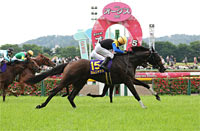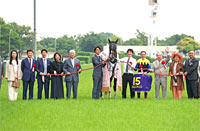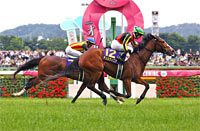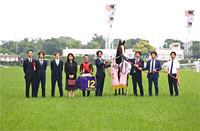Yushun Himba (Japanese Oaks) (G1) - Data Analysis
Top contest for three-year-old fillies that presents a new challenge for many runners
Of the 11 runners voted Best Three-Year-Old Filly in the JRA Awards since 2009, eight had won the Yushun Himba (Japanese Oaks). This second leg of the Triple Crown for three-year-old fillies therefore also serves as a major indicator of success in the JRA awards. In addition, of the 178 runners that have entered the race over the last 10 years, only seven had previously contested a “JRA 2,400m race” such as the Yushun Himba. This means the bulk of the runners will be contesting a race of this distance for the first time, and their ability to adapt to the distance will be a decisive factor. Let’s now analyze some features shared by successful runners in this race based on results over the last 10 years.
Recent performance is key
Of the 30 Top 3 finishers over the last 10 years, 21 had previously finished in the Top 3 of the “Oka Sho (Japanese 1000 Guineas) or Sankei Sports Sho Flora Stakes (a trial race for the Yushun Himba).” This suggest we should raise our expectations of runners that have risen to the top in the Oka Sho (the first leg of the Triple Crown for three-year-old fillies) or the Flora Stakes. [Table 1]
[Table 1] Performance by experience of finishing in Top 3 of “Oka Sho or Flora Stakes” (last 10 years)
| Experience |
Performance
[1st-2nd-3rd-4th or lower] |
Win ratio |
Top 2 ratio |
Top 3 ratio |
| Yes |
7-7-7-33 |
13.0% |
25.9% |
38.9% |
| No |
4-2-3-115 |
3.2% |
4.8% |
7.3% |
Note: Two runners tied for 1st in 2010.
In addition, among runners that had not previously finished in the Top 3 of the “Oka Sho or Flora Stakes,” runners without experience of “notching a win after passing the 4th corner in 3rd position or lower” in a “JRA open-class race held from February of the same year” struggled with a 1.1% Top 3 ratio. When comparing runners that were unable to rise to the top in the Oka Sho or Flora Stakes, we should focus on runners that triumphed after passing the 4th corner in 3rd position or lower in a graded or open-class race held from February of the same year. [Table 2]
[Table 2] Among runners that had not previously finished in the Top 3 of the “Oka Sho or Flora Stakes,” performance by experience of “notching a win after passing the 4th corner in 3rd position or lower” in a “JRA open-class race held from February of the same year” (last 10 years)
| Experience |
Performance
[1st-2nd-3rd-4th or lower] |
Win ratio |
Top 2 ratio |
Top 3 ratio |
| Yes |
4-2-2-27 |
11.4% |
17.1% |
22.9% |
| No |
0-0-1-88 |
0% |
0% |
1.1% |
Note: Two runners tied for 1st in 2010.
Runners that were highly favored in previous race perform well
Looking at performances by favoritism in the previous race, we find that runners that had been backed as “1st favorite” and “2nd favorite” achieved reasonably strong Top 3 ratios of 40.7% and 28.6%, respectively. Conversely, runners that had been backed as “6th favorite or lower” produced zero winners and struggled with a Top 3 ratio of 4.1%. When comparing performance in the previous race, we should check favoritism in that race. [Table 3]
[[Table 3] Performance by favoritism (last 10 years)
Favoritism in
previous race |
Performance
[1st-2nd-3rd-4th or lower] |
Win ratio |
Top 2 ratio |
Top 3 ratio |
| 1st favorite |
5-2-4-16 |
18.5% |
25.9% |
40.7% |
| 2nd favorite |
4-2-2-20 |
14.3% |
21.4% |
28.6% |
| 3rd-5th favorite |
2-4-2-41 |
4.1% |
12.2% |
16.3% |
| 6th favorite or lower |
0-1-2-71 |
0% |
1.4% |
4.1% |
Note: Two runners tied for 1st in 2010.
Need to discount runners with a change of jockey
Of the 30 Top 3 finishers over the last 10 years, 26 had contested their previous race with “the same jockey.” Conversely, runners that had contested their previous race with “a different jockey” struggled with a Top 3 ratio of 6.2%. In other words, we need to lower our expectations of runners that contest the race with “a different jockey” from the previous race. [Table 4]
[Table 4] Performance by jockey in previous race (last 10 years)
Jockey in
previous race |
Performance
[1st-2nd-3rd-4th or lower] |
Win ratio |
Top 2 ratio |
Top 3 ratio |
| Same jockey |
10-7-9-87 |
8.8% |
15.0% |
23.0% |
| Different jockey |
1-2-1-61 |
1.5% |
4.6% |
6.2% |
Note: Two runners tied for the 1st place in 2010.
Runners with a favorable track record at Tokyo Racecourse have an edge
Of the 30 Top 3 finishers over the last 10 years, 19 had previously won “a 1,600m+ race held at Tokyo Racecourse,” and this group of runners achieved a Top 3 ratio of 28.8%. Conversely, runners without such experience had a Top 3 ratio of only 9.8%. This suggests runners with a favorable track record in 1,600m+ races at Tokyo Racecourse (i.e., races resembling the Yushun Himba) are likely to rise to the top. [Table 5]
[Table 5] Performance by win experience in “1,600m+ race held at Tokyo Racecourse” (last 10 years)
| Win experience |
Performance
[1st-2nd-3rd-4th or lower] |
Win ratio |
Top 2 ratio |
Top 3 ratio |
| Yes |
5-7-7-47 |
7.6% |
18.2% |
28.8% |
| No |
6-2-3-101 |
5.4% |
7.1% |
9.8% |
Note: Two runners tied for the 1st place in 2010.
Runners with “6 or more” career starts have fared poorly in recent years
Of the 30 Top 3 finishers over the last 10 years, 23 had “5 or fewer” career starts. Conversely, runners that had “6 or more” career starts had a Top 3 ratio of only 7.2%, and have struggled since 2014 with performance of [0-0-1-5] (Top 3 ratio of 1.9%). In other words, we should expect little of runners with “6 or more” career starts. [Table 6]
[[Table 6] Performance by total career starts (last 10 years)
| Total career starts |
Performance
[1st-2nd-3rd-4th or lower] |
Win ratio |
Top 2 ratio |
Top 3 ratio |
| 5 or fewer |
8-8-7-58 |
9.9% |
19.8% |
28.4% |
| 6 or more |
3-1-3-90 |
3.1% |
4.1% |
7.2% |
Note: Two runners tied for 1st in 2010.
Seek out the winner!
Focus on runners with fewest reasons for uncertainty
The last six winners had all contested their previous race backed as 5th favorite or higher. Other features shared by the six winners were that they had contested their previous race with the same jockey, and that they had 5 or fewer career starts. This means we should focus on runners with the fewest reasons for uncertainty while referring to the trends in [Table 3], [Table 4], and [Table 6]. [Table 7]
[Table 7] Winners’ favoritism in previous race, jockey this time, jockey last time, total career starts (last six years)
| Year |
Winner |
Favoritism in previous race |
Jockey this time |
Jockey last time |
Total career starts |
| 2014 |
Nuovo Record |
5th favorite |
Yasunari Iwata |
Yasunari Iwata |
5 |
| 2015 |
Mikki Queen |
1st favorite |
Suguru Hamanaka |
Suguru Hamanaka |
4 |
| 2016 |
Sinhalite |
2nd favorite |
Kenichi Ikezoe |
Kenichi Ikezoe |
4 |
| 2017 |
Soul Stirring |
1st favorite |
Christophe Lemaire |
Christophe Lemaire |
5 |
| 2018 |
Almond Eye |
2nd favorite |
Christophe Lemaire |
Christophe Lemaire |
4 |
| 2019 |
Loves Only You |
1st favorite |
Mirco Demuro |
Mirco Demuro |
3 |
(Masaya Ibuki)
|




















